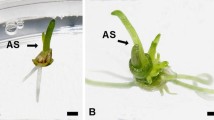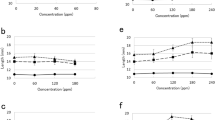Summary
-
1.
The experiments of Wickson and Thimann (1958) concerning the effect of kinetin and IAA on the sprouting of axillary buds of Pisum were repeated with slight modifications of the test with isolated nodes.
-
2.
Kinetin, given separately had a slightly suppressive effect on bud growth at the beginning of the experiment. However, after 3–4 days a significant promotion of growth could be recognized in some cases. Suppression of bud growth induced by IAA was only partially eliminated by kinetin, about 50% elimination being recognizable after 36 h (concentrations: kinetin 20 mg/l, IAA 2 mg/l).
-
3.
Furthermore the effect of kinetin was tested on pea stems according to Galston and Hand (1949). IAA increases growth of the internodes. Given separately, kinetin (0,01 mg-20 mg/l) is again either without of or slightly suppressive effect, in combination with IAA it almost totally inhibits the promotory effect of IAA (kinetin 0,2 mg/l and 20 mg/l).
-
4.
The effect of kinetin on the growth of coleoptiles of Avena is entirely different. Given alone it operates as a strong auxin in the cylinder test (optimal concentration 0,2 mg/l), in combination with IAA it enhances the effect of IAA.
-
5.
“Isolated nodes” of Pisum (according to the test of Wickson and Thimann) treated with IAA or kinetin or a combination of both for 36 h were extracted with ether, buds and stem pieces being extracted separately. The extracts were analysed by paper chromatography with isopropanol-ammonia-water 80:5:15 and then examined with the Avena cylinder test.
-
6.
In the controls — without addition of growth substances — stem pieces contained predominantly IAA, whereas buds showed an extensive suppressor zone above Rf 0.75.
-
7.
The chromatograms were not altered markedly by treatment of the test objects with IAA.
-
8.
In all series with kinetin treatment buds and stems without exception contained an auxin with an Rf of 0,63. This value corresponds to that of kinetin. On addition of an optimal amount of kinetin to the buffer solution of the cylinder test this auxin disappeared totally. Therefore it must be either identical with or closely related to kinetin. This substance, which also accumulates in Pisum buds, must be at least to some extent transportable in the plant.
-
9.
Neither the suppression of bud growth by IAA in the pea nor the elimination of this suppression by kinetin could be accounted for by appearance or disappearance of the observed auxins or suppressors.
-
10.
As far as the experiments with isolated pea nodes are concerned, the explanation given by Wickson and Thimann involving an antagonism between IAA and kinetin or some substance similar to kinetin is probably correct. However, the general validity of such an explanation for correlative suppression seems questionable.
Zusammenfassung
-
1.
Die Versuche von Wickson und Thimann (1958) über die Wirkung von Kinetin und IES auf das Austreiben der Seitenknospen von Pisum im Test mit isolierten Knoten wurden unter geringfügigen Abänderungen wiederholt.
-
2.
Kinetin, allein gegeben, wirkte zu Beginn der Versuche leicht hemmend, im weiteren Verlauf, etwa nach 3–4 Tagen, mitunter auch deutlich fördernd auf das Knospenwachstum. Die durch IES hervorgerufene Wachstumshemmung der Knospen wurde durch Kinetin teilweise, jedoch nicht vollständig, aufgehoben, nach 36 Std vielfach etwa zur Hälfte (Konzentrationen: Kinetin 20 mg/l; IES 2 mg/l).
-
3.
Die Kinetinwirkung wurde weiter noch im Erbsenstengeltest nach Galston und Hand (1949) untersucht. IES ruft in diesem Test eine starke Wachstumssteigerung der Internodien hervor. Kinetin (0,01 mg/l bis 20 mg/l) allein gegeben ist wiederum wirkungslos oder schwach hemmend; in Gemeinschaft mit IES hebt es deren fördernde Wirkung ± vollständig auf (untersucht: Kinetin 0,2 mg/l und 20 mg/l).
-
4.
Ganz anders wirkte Kinetin dagegen auf das Streckungswachstum der Avena-Koleoptile. Im Zylindertest verhielt es sich allein gegeben wie ein kräftiger Wuchsstoff (optimal war 0,2 mg/l); in Kombination mit IES verstärkte es deren fördernde Wirkung noch weiter.
-
5.
“Isolierte Knoten” von Pisum (nach der Testmethode von Wickson und Thimann), die mit IES bzw. Kinetin oder der Kombination von beiden 36 Std lang behandelt worden waren, wurden, in Knospen und Stengelstücke getrennt, mit Äther extrahiert. Die Extrakte wurden mit Isopropanaol/Ammoniak/Wasser (80:5:15) papierchromatographiert und mit dem Avena-Zylindertest geprüft.
-
6.
Bei den Kontrollen ohne Wirkstoffbehandlung enthielten Stengelstücke vorwiegend IES, Knospen zeigten eine breite Hemmstoffzone oberhalb von Rf-Wert 0,75.
-
7.
IES-Gabe führte zu keinen wesentlichen Veränderungen der Chromatogramme.
-
8.
In allen mit Kinetin behandelten Serien trat in Knospen und Stengeln ausnahmslos ein Wuchsstoff bei Rf0,63 auf. Denselben Rf-Wert besitzt auch das Kinetin. Bei Zugabe einer optimalen Kinetinmenge zur Pufferlösung des Zylindertestes verschwand dieser Wuchsstoff vollständig. Es muß sich also jedenfalls um Kinetin oder doch eine sehr nahestehende Verbindung handeln. Dieser Stoff, der sich auch in den Pisum-Knospen ansammelt, muß also wenigstens eine beschränkte Transportfähigkeit in der Pflanze besitzen.
-
9.
Weder die von der IES bewirkte Hemmung des Knospentreibens der Erbse noch die durch Kinetin hervorgerufene Aufhebung dieser Hemmung ließ sich aufgrund des Auftretens oder des Verschwindens der von mir beobachteten Wuchsstoffe und Hemmstoffe erklären.
-
10.
Für die Versuche mit isolierten Pisumknoten ist vermutlich die von Wickson und Thimann (1958) gegebene Erklärung mit dem Antagonismus von IES und Kinetin oder einer kinetinartigen Substanz richtig. Die Allgemeingültigkeit einer solchen Erklärung für die korrelative Hemmung überhaupt erscheint jedoch als zweifelhaft.
Similar content being viewed by others
Literatur
Audus, I. J.: Correlations. J. Linnean Soc. Bot. 56, 177–187 (1959).
Champagnat, P.: Dominance apicale. In: Handbuch der Pflanzenphysiologie (Herausg. W. Ruhland), Bd. XIV, S. 872–886 Berlin-Göttingen-Heidelberg: Springer 1961.
Denizci, R.: Untersuchungen über den Einfluß der Apikaldominanz auf das Wachstum der Lateralknospen verschiedener Nodien von Pisum und über die Rolle, die das Gleichgewicht von IES und Kinetin bei diesem Vorgang spielt. Unveröffentlichte Doktorarbeit. Izmir 1963.
Dörffling, K.: Über das Wuchsstoff-Hemmstoffsystem von Acer pseudoplatanus L. Planta (Berl.) 60, 390–412 (1963).
Engelbrecht, L.: Über Kinetinwirkungen bei intakten Blättern von Nicotiana rustica. Flora (Jena) 154, 57–59 (1964).
, u. K. Conrad: Vergleichende Untersuchungen zur Wirkung von Kinetin und Auxin. Ber. dtsch. bot. Ges. (Stuttgart) 74, (42–44) (1961), Sondernummer.
Fischer, A.: Papierchromatographische und papierelektrophoretische Trennung von Indolderivaten. Planta (Berl) 43, 288–314 (1954).
Galston, A. W., and M. E. Hand: Studies on the Physiology of light action. I. Auxin and the ligth inhibition of Growth. Amer. J. Bot. 36, 85–94 (1949).
Libbert, E.: Kontrolliert Auxin die Apikaldominanz? Physiol. Plantarum (Kbh.) 17, 371–378 (1964).
, u. H. Liebenow: Papierchromatographische Untersuchung der Hemmstoffe aus Erbsenpflanzen (einschließlich-des Korrelationshemmstoffes) und ihrer Wirkung in verschiedenen Biotests. Planta (Berl.) 60, 582–597 (1964).
Nitsch, J. P., and C. Nitsch: Studies on the growth of coleoptile and first internode sections. A new, sensitive straigth-growth test for Auxins. Plant Physiol. 31, 94–111, cp. p. 104 (1956).
Overbeek, J. v.: Auxin distribution in seedlings and its bearing on the problem of bud inhibition. Bot. Gaz. 100, 133–166 (1938).
Söding, H.: Die Wuchsstofflehre. Stuttgart: Georg Thieme 1952.
Sorokin, H. P., and K. V. Thimann: The histological basis for inhibition of axillary buds in Pisum sativum and the effects of auxins and kinetin on xylem development. Protoplasma (Wien) 59, 326–350 (1964).
Thimann, K. V., and M. M. Laloraya: Changes in pea stem sections under the action of kinetin. Physiol. Plantarum (Kbh.) 13, 165–178 (1960).
Thimann, K. V., and M. Wickson: Experiments on the physiology of apical dominance. Colloqu. Internat. sur le Photothermoperiodisme, Parma 1957.
Vardar, Y.: A study on the apical bud inhibition upon the lateral branches. Rev. Fac. Sci. Univ. Istanbul. XX/B 3, 245–256 (1955).
Wickson, M., and K. V. Thimann: The antagonism of auxin und kinetin in apical dominance. Physiol. Plantarum (Kbh.) 11, 62–74 (1958).
: The antagonism of auxin and kinetin in apical dominance. II. The transport of IAA in pea stems in relation to apical dominance. Physiol. Plantarum (Kbh.) 13, 539–554 (1960).
Witt, J.: Über den Einfluß von Stickstoffmangel auf den Wuchsstoffhaushalt von Helianthus annuus L. Port. Acta biol. 8, 195–247 (1964).
Author information
Authors and Affiliations
Rights and permissions
About this article
Cite this article
Denizci, R. Über den Einfluss von Kinetin und Indolylessigsäure auf das Austreiben der Knospen von Pisum sativum . Planta 68, 141–156 (1966). https://doi.org/10.1007/BF00385622
Received:
Issue Date:
DOI: https://doi.org/10.1007/BF00385622




